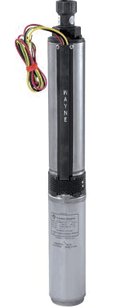You don't the permission to view this video
 Consists of a pump, a pressure tank and switch.
Consists of a pump, a pressure tank and switch.- The tank will supply water between the cut-on and cut-off pressure setting on the pump, usually 20-40 psi. While 20-40 lbs. pressure is adequate, 30-50 lbs. or 40-60 lbs. is best for home supplies. Since the tank supplies small amounts of water, the pump does not have to turn on each time a faucet is used.
- Pumps are shallow-well or deep-well. Shallow-well pumps are installed at well depths of 25' or less. Where deep-well pumps can be used in water depths of 300' or greater, depending on altitude.
- Horsepower rating determines pump size. Pumps used in theaverage home are 1/3-, 1/2-, 3/4- or 1-hp. When choosing a pump, find the required capacity by counting the number of faucets in the home (count tub faucets as two) and multiplying by 60. This is the number of gallons-per-hour the pump should supply from the well. Always allow for additional appliances that use water or for appliances you may add in the future.
- Home water-system pumps are usually centrifugal or jet. This type builds a centrifugal force, which lifts the water.
- Older homes may have a piston pump. A piston pump builds pressure that pulls water up through the casing.
- There are several important terms to know when selling a pump: Well-sized. The inside diameter of the well indicates proper size pump, ejector, cylinder or drop pipe (pipe that is lowered into well casing to transport the water) and foot valve (located at the bottom of the drop pipe to keep water from flowing backward into the well).
- Pumping level. The vertical distance in feet from pump to water level while the pump is operating. If pump is installed away from the well and is on higher ground, this elevation must also be included.
- Most wells draw down (water level goes down inside the well as water is pumped into the home) so this must not be confused with standing water level.
- Average discharge pressure: The usual average discharge pressure is 30 lbs., halfway between the 20-40 lb. switch setting of most water systems. When the tank is installed away from the pump at a higher level or when house or yard fixtures are above the pump and tank, a greater pressure is needed and a larger pump must be used.
- Capacity required: This is the discharge capacity of the pump in gallons per hour necessary for satisfactory service. The pump should have enough capacity so that it does not need to work more than the equivalent of two hours a day in intermittent service.
- Well points: These are used to drive wells in soil that is soft and primarily free of rock and where water is known to be close to the surface. Points are screwed onto the end of pipe to be lowered into the ground; then the point and pipe are driven into the ground with a sledgehammer or mallet. Well points have strainer baskets on the ends that sift out dirt and small stones.



Comments (0)